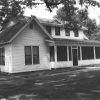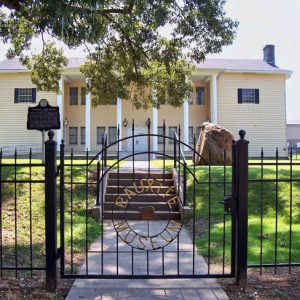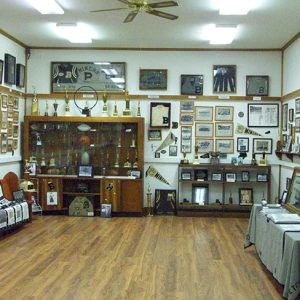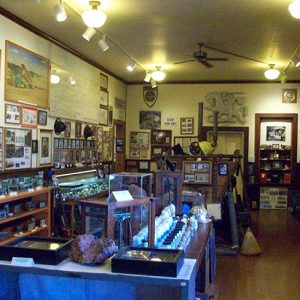calsfoundation@cals.org
Bauxite Historical Association and Museum
The Bauxite Historical Association and Museum (BHAM) works to preserve the history and culture of the company-owned town of Bauxite (Saline County). The organization started its life as the Alcoa Employees Descendants Association (AEDA), which was created on October 15, 1986, as a non-profit organization charged with the maintenance, protection, and everyday business of the Bauxite Community Hall and all other property deeded to it by the Aluminum Company of America (Alcoa).
The community hall building houses the Bauxite Historical Museum. The building’s main hall is run by the association and functions as a venue for local events. The community hall was finished in 1926. Built by the Republic Mining & Manufacturing Company, the building itself was dedicated as the Bauxite Community Hall on June 15, 1926. After the building was opened, a room was set aside upstairs to be used for meetings of the Bauxite Eastern Star Masonic Lodge. The hall’s grounds included a nine-hole golf course and a two tennis courts. At the time of its construction, the community hall had a smoking room, a library, Girl Scout and Boy Scout rooms, a lodge hall upstairs, a basketball court/auditorium, and a kitchen. All of this was paid for through a twenty-five-cent tax paid by each employee’s paycheck until the total cost was recouped by the company. In addition, Clear Lake was built nearby to serve as a resort for Alcoa employees and their families.
On June 19, 1967, residents of Bauxite received notifications in the mail from Alcoa stating that, as of July 1, 1969, the company would no longer support the town. What houses and buildings that remained in the area were either sold, moved to Benton (Saline County), or destroyed. At a town meeting on February 1, 1986, at the Bauxite Community Hall, a board of directors was elected to be the first governing body of the AEDA. On May 24, 1986, the Sally Donner Room was set aside to house a collection of artifacts and a small library. Soon after, three more rooms were opened. On October 15, 1986, Alcoa deeded the building and other properties still owned by the company—namely, the Rucker House (located directly across from the community hall), the land next to and around the hall, and the Bauxite Cemetery—to the AEDA. A few years after that, the group changed its name to the Bauxite Historical Association and Museum or BHAM.
The Kimbrough Room across from the Donner Room houses mining equipment, geological specimens, and other Alcoa memorabilia. A small hallway leading from the Kimbrough Room to the Hines Room is a tribute to Bauxite’s ethnic diversity. The Hines Room pays tribute to Bauxite’s impact on the World War II effort. Attached to the Hines Room is the Bono Room, which houses a large collection of sports memorabilia. The museum’s collection consists of documents, photographs, mining equipment, books, aluminum wares, school memorabilia, and items created by Alcoa. One of these items is a dress made from aluminum thread and designed by fashion designer Jean Desses of Paris, France. The $25,000 dress was worn by Miss Arkansas at the Aluminum Bowl game at War Memorial Stadium on December 22, 1956. It debuted in Paris at various fashion shows before making its American debut at a Neiman-Marcus Awards Dinner in Dallas, Texas. It was also featured on television’s Ed Sullivan Show and the Today Show with Dave Garroway. Another curious artifact in the museum is a set of “bauxite teeth” in the Donner Room; they were donated by a man who had teeth pulled so he could get dentures. Because the process of turning raw bauxite ore, or alumina, into aluminum required fluoride, some of it made its way into the town’s drinking supply, staining the townspeople’s teeth brown. However, dentists found out that the excess fluoride made the teeth much stronger than usual.
In April 1999, steps were taken by BHAM to resurrect the old Alcoa newspaper, Pick and Shovel, as its official newsletter. The Bauxite Historical Association contacted the local Alcoa office to ask for permission to use the paper’s name and likeness for its newsletter. In 1999, the new Pick and Shovel was born after a forty-one-year hiatus. Alcoa also donated more than 300 black-and-white negatives. Longtime Pick and Shovel editor and columnist for the Saline Courier Ginger Fox English took the negatives to Bedford Camera & Video in Little Rock (Pulaski County) to be digitized. The museum began selling copies of these rare and candid photographs from the town’s heyday.
In 2008, the family of H. Tyndall Dickinson commissioned a large bronze statue titled Unsung Heroes–Bauxite Miners to be erected on the community hall’s grounds. The statue was cast in bronze by Gary Alsum and depicts a father, dressed in overalls, saying goodbye to his family as he goes to work in the mines. His son plays with a toy airplane while his wife embraces him, holding their young daughter in her arms. The sculpture was unveiled on the front lawn of the Bauxite Community Hall in October 2008.
In 2012, a new elevator was added in the Kimbrough Room, and the museum was expanded to include the top floor. Every Memorial Day weekend, a town reunion is held at the Bauxite Community Hall.
For additional information:
English, Ginger. Miner Memories. San Bernardino, CA: CreateSpace Independent Publishing, 2015.
Morden, Ethel Lewellen. Bauxite: The Last Stop before Heaven. Waldron, AR: T&E Printing Services, 1986.
Schnedler, Jack. “Bauxite Helped Win World War II.” Arkansas Democrat-Gazette, March 19, 2024, p. 6E. Online at https://www.arkansasonline.com/news/2024/mar/18/arkansas-sightseeing-bauxite-dug-in-for-its-role/ (accessed March 19, 2024).
Cody Lynn Berry
University of Arkansas at Little Rock
 Bauxite Mining
Bauxite Mining Campbell, Leon "Muscles"
Campbell, Leon "Muscles" Divergent Prosperity and the Arc of Reform, 1968–2022
Divergent Prosperity and the Arc of Reform, 1968–2022 Historic Preservation
Historic Preservation Museums
Museums Rucker House
Rucker House Bauxite Historical Museum
Bauxite Historical Museum  Bono Room
Bono Room  Kimbrough Room, Bauxite Museum
Kimbrough Room, Bauxite Museum 




I am looking forward, along with my older son, David Rollins, to attending the reunion this year, 2023.